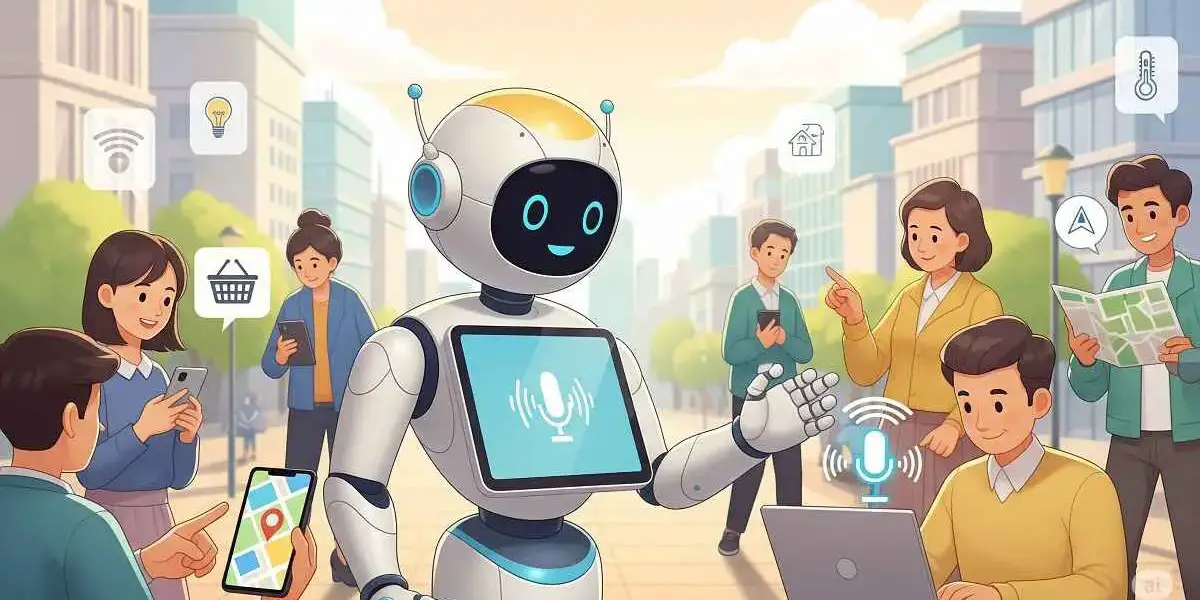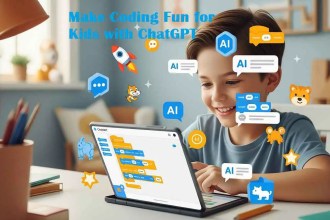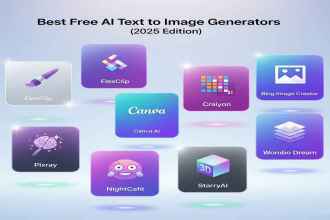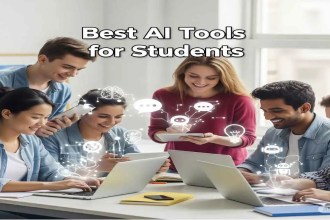We all were beginners once, asking ‘how does artificial intelligence work?’ and hoping for a simple answer. Here it is: AI is not magic but a system that learns from data and then makes guesses or decisions from it. Learning is like practice — the more examples you give, the smarter it becomes.
In very short, AI takes some input like text, photo, or voice, finds patterns, and gives back an output like an answer, advice, or action. You already see this daily in Google search, YouTube, or shopping apps.
- What Exactly Is Artificial Intelligence (An Overview)?
- How Does Artificial Intelligence Work? (Simple Explanation)
- AI Overview: What Runs Behind the Scene
- How AI Works Explained with Real Examples
- Why Data Is Everything in AI
- Types of AI You Should Know
- Tools and Techniques AI Uses
- Key Facts About How AI Works
- Ready-to-Use Ways AI Can Help You Right Now
- Important Points to Remember About AI
- How Does Artificial Intelligence Work – Key Takeaways
This guide will explain the basics of Artificial intelligence in simple language. We’ll move beyond theory with clear examples, ready-to-use tips, and real facts. By the end, you will be able to tell anyone clearly how AI works.
What Exactly Is Artificial Intelligence (An Overview)?
AI is like giving a machine a brain. A daily-use machine, like a calculator, only does exactly what you tell it to do. An AI-enabled system, however, can learn from old data, check patterns, and make decisions based on what it has learned. Its “brain” is actually a complex web of patterns and probabilities it has calculated from thousands of examples.
📌 Simple Fact:
- Calculator = simple machine (follows only commands).
- Google Translate = AI (learns patterns from millions of translations).
So, AI isn’t magic. It’s the capability to learn from data and then use that knowledge to make a decision or a prediction.
How Does Artificial Intelligence Work? (Simple Explanation)
AI always works in a step-by-step process. You can remember it like this:
- Input (data goes in) – photos, videos, numbers, text, voice.
- Processing (rules + learning) – machine finds patterns, connects dots.
- Learning (improve with time) – more examples, better accuracy.
- Output (decision/action) – answer, prediction, or suggestion.
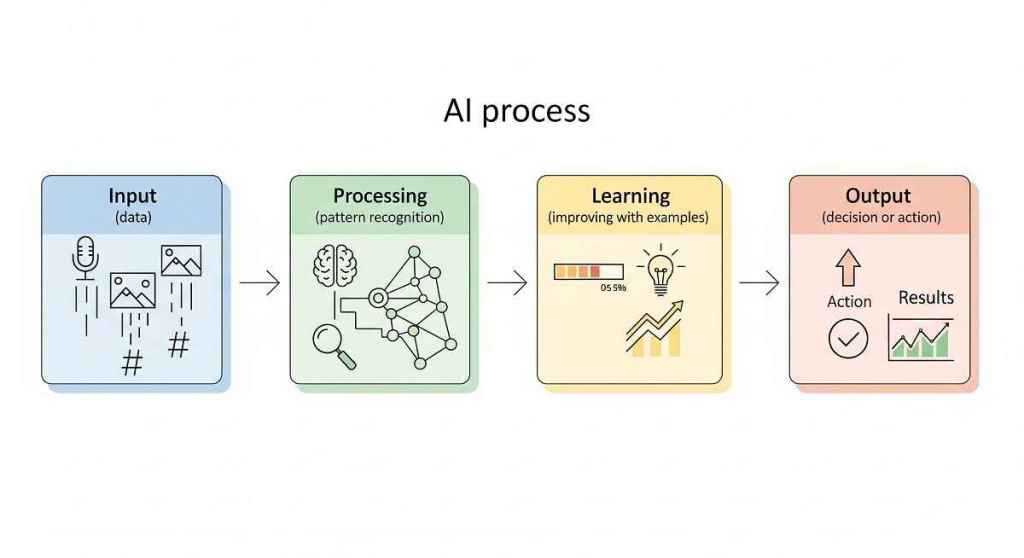
You might think the interaction with a AI tool like ChatGPT is it “learning” in real-time. In reality, the learning happens in two big phases:
- Training: Developers feed the AI a huge amount of data, and its algorithms adjust trillions of internal settings to learn the patterns. This is like a student studying for months for a final exam.
- Inference: This is the trained AI being used. When you ask ChatGPT a question, it’s not learning from you; it’s using its pre-trained knowledge to generate an answer—it’s taking the exam.
💡 Like a child learning alphabets. At first, they see A many times, then they know it. After more practice, they can read words. AI also learns step by step from data.
AI Overview: What Runs Behind the Scene
When you see AI giving answers or making smart decisions, it looks very smooth from outside. But behind the scene, four main things are working together: data, algorithms, models, and feedback. If you understand these four, you understand the heart of AI.
Data is the fuel
AI cannot think without data. Data is like food or petrol for the system. The more data you give, the better it learns. For example, if you train an AI with only 100 photos of cats, it will make mistakes. But if you train it with 1 million photos, it becomes very accurate. This is why apps like Google Photos or Google Translate work so well — they were trained on huge, global data.
👉 Ready-to-use tip: When you use any AI writing tool like ChatGPT, try giving more details in your prompt (that is your “data”). More input details = better output.
Algorithms are the brain
Data alone is useless without rules to process it. Algorithms are like recipes that tell the machine how to mix and cook the data. For example, in Netflix, the algorithm studies what movies you watched before, compares it with what other people watched, and then suggests a movie you may like. Different algorithms can produce very different results, even from the same data.
👉 Ready-to-use tip: Try changing your “settings” or “filters” in apps like YouTube or Spotify. You are indirectly tweaking the algorithm to give better recommendations.
Models are the memory
Once AI is trained, it does not need to re-learn everything each time. It saves what it learned in a model. That model is like the memory of a student after exams. For example, Face ID on your phone already has a stored model of your face. So every time you unlock, it compares your face with the stored memory — it doesn’t learn again.
👉 Ready-to-use tip: In AI art tools like DALL·E or Canva AI, the “style models” are memory blocks. If you select a cartoon style or realistic style, you are choosing from saved models.
Feedback is improvement
AI is never perfect the first time. It gets better when people correct it or when it sees its own mistakes. For example, Gmail spam filter was weak in the beginning, but with millions of people marking “this is spam,” it improved quickly. The same happens with language models like ChatGPT or Bard — feedback trains them further.
👉 Ready-to-use tip: When an AI tool gives you a wrong or weak answer, don’t just stop. Give it feedback by rephrasing your input or clicking options like “thumbs down.” This helps both you and the AI.
How AI Works Explained with Real Examples
The easiest way to understand AI is by looking at how it works in real tools around you. Let’s see three strong examples and break them step by step.
- Speech Assistant (Siri, Alexa, Google Assistant)
- Input: Your voice “Play music.”
- Processing: AI breaks voice into text + checks grammar.
- Output: Starts music instantly.
- Self-driving Car (Tesla, Waymo)
- Input: Sensors, cameras, GPS.
- Processing: Detect traffic lights, people, and road signs.
- Output: Car moves safely without driver.
- E-commerce (Amazon, Flipkart)
- Input: Your shopping history.
- Processing: Learns your likes.
- Output: Shows you “Recommended Products.”
📌 Try Yourself: Next time you see YouTube suggesting videos, notice how it changed after you watched just 2-3 different topics. That’s AI adapting to your pattern.
Why Data Is Everything in AI
AI is like a mirror. If you give it good data, it gives good output. If data is wrong, output is wrong.
- Biased Data → Biased AI
- Less Data → Weak AI
- More Clean Data → Strong AI
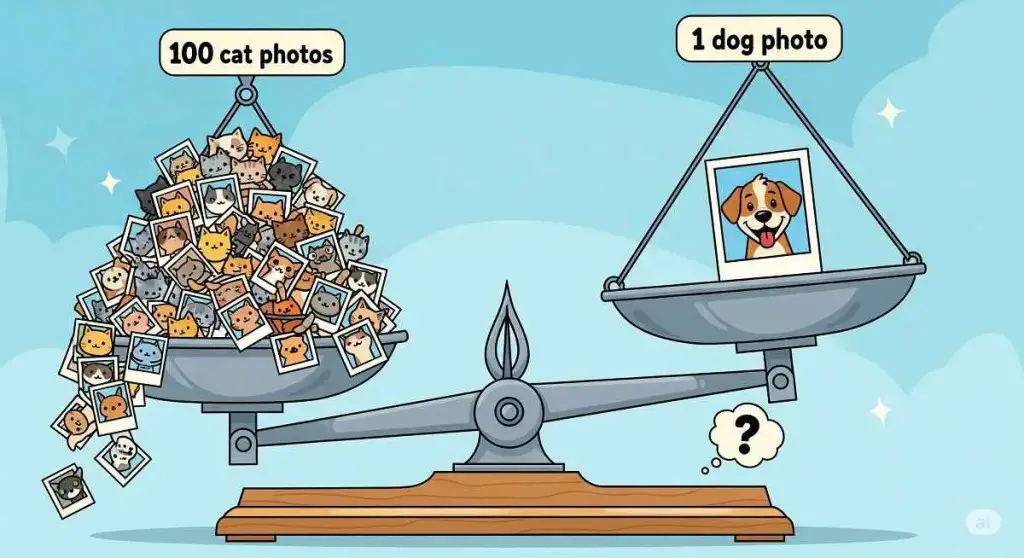
📌 Example You Can Relate:
If you train AI with 100 photos of cats but only 1 photo of dogs, it will call almost everything a cat.
Types of AI You Should Know
AI is not just one kind. Experts normally divide it into three types. One type is already around you every day, one is still only in labs and experiments, and the last one is more like a future dream.
Narrow AI (Weak AI)
Narrow AI is the kind we already use all the time without even thinking. It is called narrow because it can only do one job at a time, but it does that job extremely well. For example, Google Maps finds the fastest route for your journey, but it cannot answer your health questions. A chatbot like Siri or Alexa can talk with you, but it cannot drive your car. Even the “Face Unlock” on your phone is Narrow AI because it only knows how to check if it is your face.
This type of AI is everywhere today — in Netflix showing you movies, in Gmail filtering spam, in Amazon recommending products. If you want to try Narrow AI yourself, you can use tools like Google Translate (for languages), Grammarly (for writing help), or Canva AI (for design ideas). All of these are Narrow AI, because each one is a master in only one area.
General AI (Strong AI)
General AI, sometimes called Strong AI, is the type still being researched. This would be a system that can think and learn across many different areas, just like humans do. Right now, AI cannot do that. A chatbot may be great at language, but it cannot suddenly learn to drive. A self-driving car may be good at traffic, but it cannot start writing essays.
General AI would change that. Imagine one AI brain that could write your homework, solve maths, drive your car, cook food, and maybe even learn new skills by itself. This is why scientists are very excited about it. But for now, General AI does not exist outside research. If you are curious, you can read about projects like OpenAI’s work on advanced language models or DeepMind’s experiments with learning systems. These are small steps moving toward General AI.
Super AI (Artificial Superintelligence)
Super AI is an idea where machines could become smarter than humans in every possible way. It does not exist today and maybe not for many decades, but it is often shown in movies and books. Super AI could be able to think, plan, and create in ways humans cannot even imagine.
This type raises serious questions. If machines get much smarter, how will humans keep control? Who will take decisions — humans or machines? Some people see Super AI as a big chance to solve world problems like climate change or health. Others see it as a risk if machines start working against human values.
For now, Super AI is just theory, but it is good for you as a reader to know about it. Whenever you hear news about AI “taking over the world,” it usually means people are talking about this Super AI concept.
Tools and Techniques AI Uses
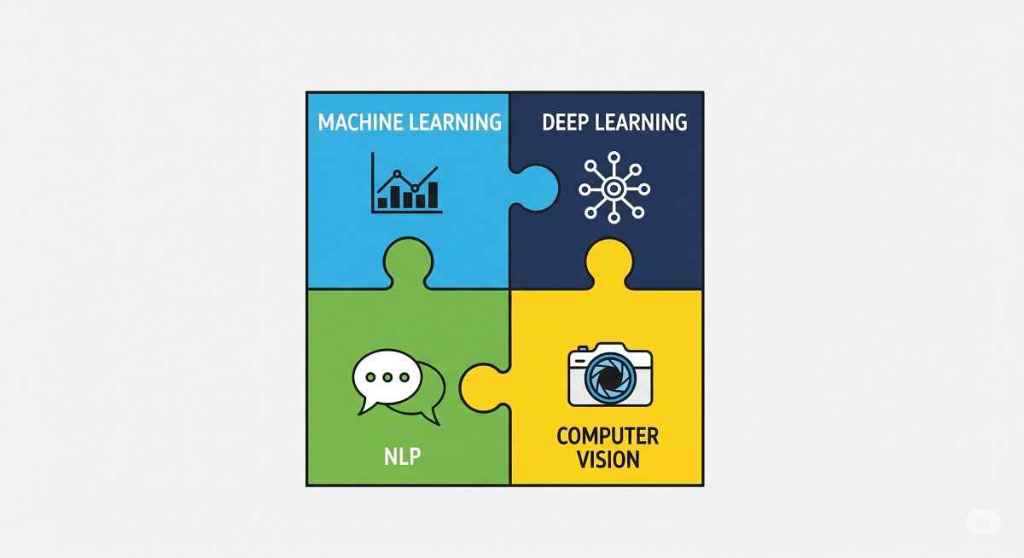
Machine Learning (ML): AI learns from examples (like training a student with past exam papers).
Deep Learning (DL): Uses neural networks, which are like mini simulations of the human brain, to process complex patterns (used in voice assistants, facial recognition).
Natural Language Processing (NLP): Helps AI understand and generate human language – used in tools like ChatGPT or Google Translate.
Computer Vision: Lets AI “see” and interpret images or videos – used in self-driving cars, face unlock, and Google Lens.
📌 Try This Yourself:
- Use ChatGPT to summarize an article – see how NLP works.
- Try Google Lens on your pet – watch how AI guesses the breed.
Key Facts About How AI Works
- AI doesn’t think like human, it just learns patterns.
- More data = better performance.
- It needs training before use (like humans need study).
- Mistakes = learning chance.
- It keeps improving with updates.
📌 Quick Use Idea: If you are learning coding, try GitHub Copilot. It uses AI to suggest code instantly as you type.
Ready-to-Use Ways AI Can Help You Right Now
Here are practical things you can try today:
- AI Writing Tools – Grammarly, ChatGPT → improve emails, blogs.
- AI Translation – Google Translate, DeepL → talk with people in other languages.
- AI Image Tools – Canva AI, DALL·E → create designs in seconds.
- AI Study Tools – Quizlet AI, Khan Academy AI → explain tough subjects in easy words.
- AI Health Trackers – Fitbit AI, Apple Health → check steps, heart rate.
Important Points to Remember About AI
It’s a Tool: It aligns with the goals and inherits the biases of its creators and data.
Your Own Privacy: Most AI systems depend heavily on data, so you should care to know how your data is used.
It’s Not Perfect: AI can also make mistakes (a.k.a. “hallucinations”) and should only be used with critical thinking.
How Does Artificial Intelligence Work – Key Takeaways
So if anyone throws at you this question – “how does artificial intelligence work?” you can explain in one line:
👉 AI works by learning from past data, finding patterns, and making decisions or predictions using those patterns.
But more than that, AI is something you can already use in your daily life – from maps, translation, shopping, to health.
📌 Quick Action for Reader:
Try any one AI tool today (like Google Lens, ChatGPT, or Grammarly). You will instantly understand how AI is working in background for you.
